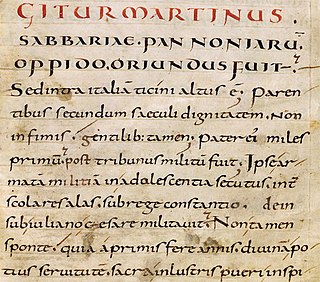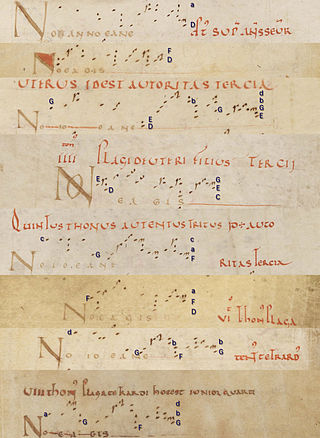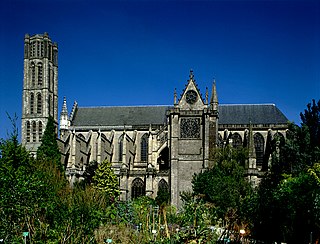Related Research Articles

A hagiography is a biography of a saint or an ecclesiastical leader, as well as, by extension, an adulatory and idealized biography of a preacher, priest, founder, saint, monk, nun or icon in any of the world's religions. Early Christian hagiographies might consist of a biography or vita, a description of the saint's deeds or miracles, an account of the saint's martyrdom, or be a combination of these.

Martial, called "the Apostle of the Gauls" or "the Apostle of Aquitaine", was the first bishop of Limoges. His feast day is 30 June.

Adémar de Chabannes was a French/Frankish monk, active as a composer, scribe, historian, poet, grammarian and literary forger. He was associated with the Abbey of Saint Martial, Limoges, where he was a central figure in the Saint Martial school, an important center of early medieval music. Much of his career was spent copying and transcribing earlier accounts of Frankish history; his major work was the Chronicon Aquitanicum et Francicum.

Dagobert II was a Merovingian king of the Franks, ruling in Austrasia from 675 or 676 until his death. He is one of the more obscure Merovingians. He has been considered a martyr since at least the ninth century.

Leodegar of Poitiers was a martyred Burgundian Bishop of Autun. He was the son of Saint Sigrada and the brother of Saint Warinus.
The Saint Martial School was a medieval school of music composition centered in the Abbey of Saint Martial, Limoges, France. Most active from the 9th to 12th centuries, some scholars describe its practices, music, and manuscripts as 'Aquitanian'. It is known for the composition of tropes, sequences, and early organum. In this respect, it was an important precursor to the Notre Dame School. Adémar de Chabannes and his nephew Roger de Chabannes were important proponents of this school whose hands had only be recently discovered by studies of James Grier between 1995 and 2005. They invented a local variant of a vertically precise organisation of notation and a new form of local tonary, they reorganised existing chant manuscripts, and they developed the libellum structure of a new type of sequentiary troper whose organisation was new at their time, but played a key role for the Saint Martial school.

The Diocese of Limoges is a Latin Church diocese of the Catholic Church in France. The diocese comprises the départments of Haute-Vienne and Creuse. After the Concordat of 1801, the See of Limoges lost twenty-four parishes from the district of Nontron which were annexed to the Diocese of Périgueux, and forty-four from the district of Confolens, transferred to the Diocese of Angoulême; but until 1822 it included the entire ancient Diocese of Tulle, when the latter was reorganized.

A cephalophore is a saint who is generally depicted carrying their own severed head. In Christian art, this was usually meant to signify that the subject in question had been martyred by beheading. Depicting the requisite halo in this circumstance offers a unique challenge for the artist: some put the halo where the head used to be, others have the saint carrying the halo along with the head, and some split the difference. Associated legends often tell of the saint standing and carrying their own head after the beheading.
Lupus I was the duke of Gascony and part of Aquitaine in the Merovingian kingdom during the 670s. He may have started a dynasty, since the next-known duke of Gascony was Lupus II . Lupus was probably the successor of Felix, whose duchy seemed to encompass almost an identical territory to the kingdom of Charibert II. Sometime after 658, Lupus rebelled against Felix and later succeeded him. According to the Miracles of Saint Martial, the rebellion occurred during the mayorship of Ebroin.

Rodulf was the archbishop of Bourges from 840 until his death. He is remembered as a skillful diplomat and a proponent of ecclesiastical reform. As a saint, his feast has been celebrated on 21 June.

Opportuna of Montreuil was a Frankish Benedictine nun and abbess. A Vita et miracula Sanctae Opportunae was written within a century of her death by Adalhelm, bishop of Séez, who believed he owed his life and his see to Opportuna.
Goscelin of Saint-Bertin was a Benedictine hagiographical writer. He was a Fleming or Brabantian by birth and became a monk of St Bertin's at Saint-Omer before travelling to England to take up a position in the household of Herman, Bishop of Ramsbury in Wiltshire (1058–78). During his time in England, he stayed at many monasteries and wherever he went collected materials for his numerous hagiographies of English saints.

Óláfs saga helga or the Saga of St. Olaf, written in several versions, is one of kings' sagas on the subject of King Olaf Haraldsson the Saint.
Trofimena is a female saint canonised in the Roman Catholic Church. Originally from the town of Patti in Sicily, the relics of Trofimena are venerated in the basilica in the town of Minori, Italy on the coast of Amalfi, southern Italy.

The Miracles of Saint Demetrius is a 7th-century collection of homilies, written in Greek, accounting the miracles performed by the patron saint of Thessalonica, Saint Demetrius. It is a unique work for the history of the city and the Balkans in general, especially in relation to the Slavic invasions of the late 6th and 7th centuries, which are otherwise neglected by contemporary sources.
The Miracula sancti Martialis anno 1388 patrata is a dossier of 73 miracles performed through the intercession of Saint Martial between 1378 and 1388. The Latin manuscript was found in the seminary of Nîmes by the Bollandists François Arbellot and Charles De Smedt, who edited and published it.
Sigrada of Alsace was a Franco-Burgundian countess and mother of Ss. Warin, and Leodegar, and grandmother of St. Leudwinus.

The Gesta Dagoberti, fully Gesta domni Dagoberti regis Francorum, is an anonymous Latin biography of Dagobert I, king of the Franks (623–639). It combines deeds from the life of Dagobert with numerous accounts of miracles to present Dagobert as a saint and the founder of the Abbey of Saint-Denis. It was written in the early 9th century. As a historical source, it is "extremely unreliable", but not totally useless.
Ansoald was the bishop of Poitiers from 676 until about 696.
The Great Chronicle of Limoges, also called the Chronicle of Saint-Martial of Limoges, is a collection of 13th- and 14th-century historical notices and chronicles of Limoges preserved in three related manuscripts. Beginning in the 18th century, the material in the manuscripts was mistakenly perceived as fragments of a single large chronicle of the abbey of Saint-Martial. They were first critically edited as a unified chronicle in the 19th century. They are today recognized mostly as notes made by the monks of Saint-Martial as continuations of the copious historical notes made by Bernard Itier.
References
- ↑ Full title: Miracula sancti Martialis episcopi Lemovicensis, "Miracles of Saint Martial, Bishop of Limoges".
- ↑ Auguste Molinier, Les Sources de l'histoire de France: Des origines aux guerres d'Italie (1494), I. Époque primitive, mérovingiens et carolingiens (Paris: A. Picard et fils, 1901), p. 70, no. 206 (Miracula S. Martialis).
- ↑ Paul Fouracre and Richard Gerberding, edd., Late Merovingian France: History and Hagiography, 640–720 (Manchester: Manchester University Press, 1996), p. 291n.
- ↑ Ian N. Wood, "Frankish Hegemony in England", The Age of Sutton Hoo: The Seventh Century in North-Western Europe, ed. Martin Carver (Woodbridge: Boydell, 1992), p. 236.
- ↑ Archibald R. Lewis, "The Dukes in the Regnum Francorum, A.D. 550–751", Speculum 51.3 (1976), pp. 381–410, at 401.